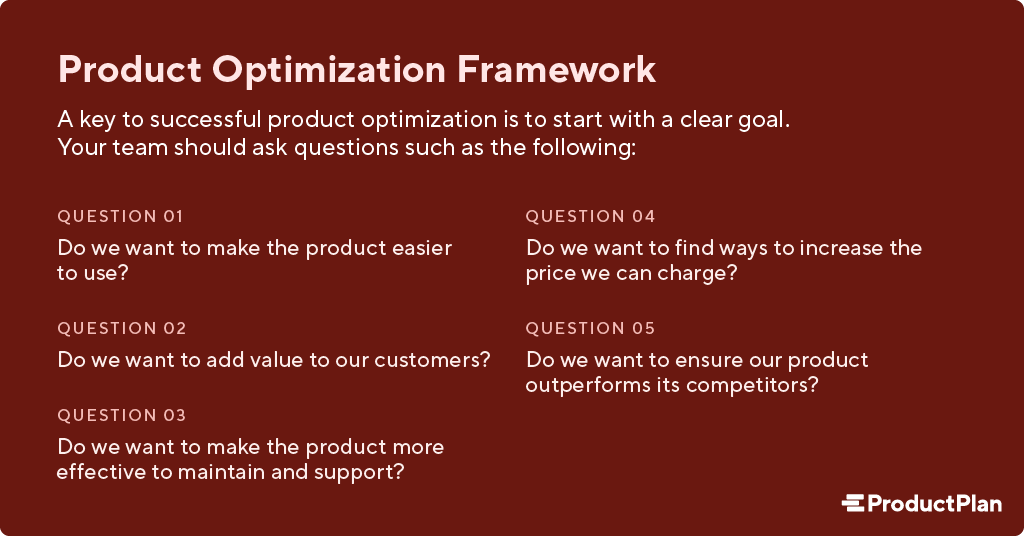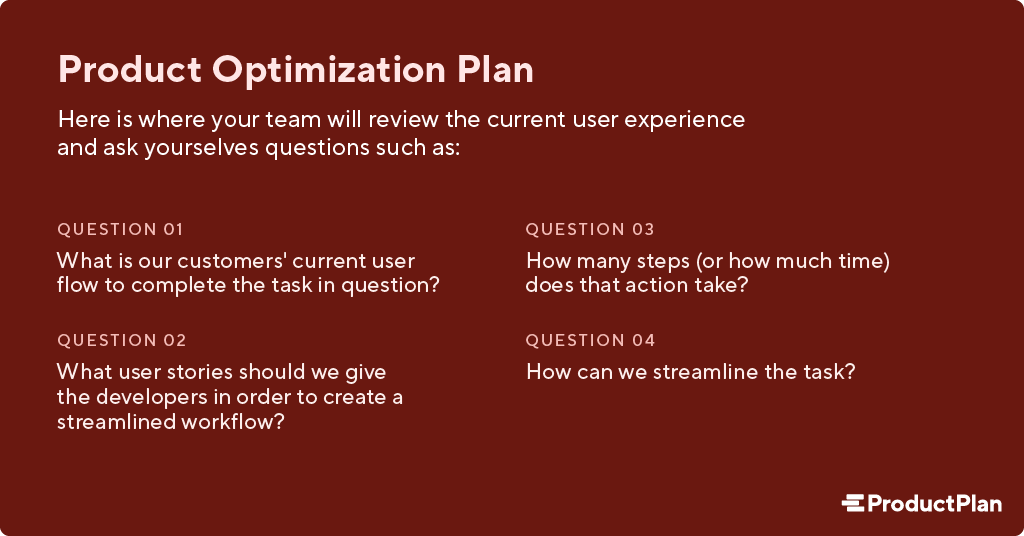What is Product Optimization?
Product optimization is the process of refining and improving a product to make it more valuable to current users and more attractive to new ones.
As a product manager, you should optimize your product pre-launch during the initial development. The process should continue after the product hits the market and until your company sunsets it. Product optimization is never complete, and you should weave it throughout your product’s lifecycle.
Example of a Product Optimization Framework
Optimizing your product can mean many different things.

Download The Product Strategy Playbook ➜
Product Optimization Frameworks vary by company goals
When you’ve identified your objective, you can begin taking appropriate steps to optimize your product. The framework you choose will differ based on the objective. But in every case, the first step is the same: Identify your goal.
Step 1: Identify your goal.
Let’s imagine your company makes SaaS software, and your team wants to make your app easier to use.
Step 2: Determine your success metrics.
Next, you will need a way to quantify whether your team’s work makes your product more user-friendly. Your success metric, in this case, would be whether users can complete a specific task in your product in less time or with fewer clicks.
Step 3: Devise and execute your product optimization plan.
Now you’ll need to create a specific plan to make your app more intuitive.

When you have your plan, please share it with your development team. You will want to discuss the details with them because your developers might have ideas to streamline the workflow that your team didn’t think of.
Step 4: Test your work against your success criteria.
When development builds the new functionality, you will want to test it with users to find out whether the new version achieves your goals. In this case, we recommend using an A/B test.
How an A/B test can work
Now that you have the existing and new versions of your app, you can create a test group to measure both versions against each other. You and your team believe the new version provides a more intuitive path to completing a task. But your users might not see it that way, and they might view the new functionality as more confusing than the user flow in your existing app.
To conduct the A/B test, you will invite a group of users to try your product. You’ll ask them all to perform the same task in your app while your team monitors what they do.
Half of these users will perform the task using your existing app, and the other half will use the new version.
You’ll record everyone’s steps as well as the time it takes them to complete the task in question. Then you can review both groups’ sessions to determine whether your newer version made the app more intuitive and user-friendly.
Product Optimization Best Practices for Product Managers
Whatever your strategic goal and whichever framework you select, you will want to follow a few product-optimization best practices that apply to any situation.
1. Share your plan with stakeholders.
Share your plans and reasoning with relevant stakeholders before you begin making changes to your product roadmap or adding new priorities to your product roadmap.
When they understand your objective to continually make your product better, faster, and more valuable to users, your coworkers will be more inclined to help. On the flip side, your team will be less likely to support you if they see you’re adding or removing functionality but don’t know why.
2. Set a timeline for each optimization.
A product optimization initiative can go on forever. You can tweak and refine your product updates so long that the new functionality never reaches your users. To combat this, give yourself a timeline.
Check your team’s work against your success criteria. If your optimization strategy worked—if it met your criteria—then stop the tweaking and release the product. Remember, optimization is an ongoing process, so you can always make more updates later.
3. Let your customers know what you’re doing.
You will also want to let your user base know that your team is always looking for ways to make your product more valuable to them.
When you optimize the product, send a message to customers. It sends an important signal that you care about them and strive to make your product as beneficial to them as possible.
4. Welcome optimization ideas from your internal stakeholders.
Product optimization should not be the sole responsibility of a company’s product management department. People and teams across your company might also have insights and suggestions to improve your product.
Your sales and customer success teams, for example, are probably hearing things from the market that you could use to optimize your product. Encourage their suggestions.
5. Give product optimization an ongoing role in your product’s lifecycle.
Finally, you’ll want to remember that optimizing your product never ends. No product is ever fully optimized, and you can always find ways to make it better and more valuable to users.
Make optimization an ongoing part of your product planning process.
Related Terms
A/B test / prioritization / product analytics / user research / product-led growth /
